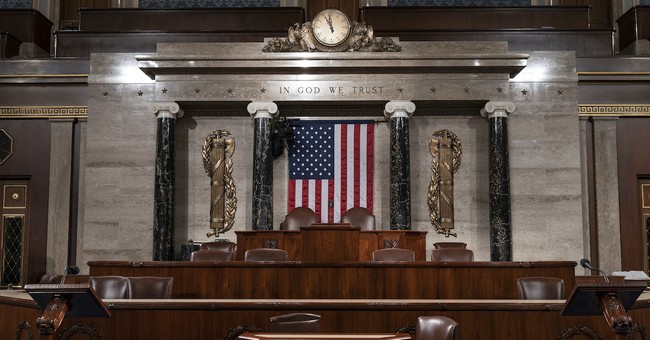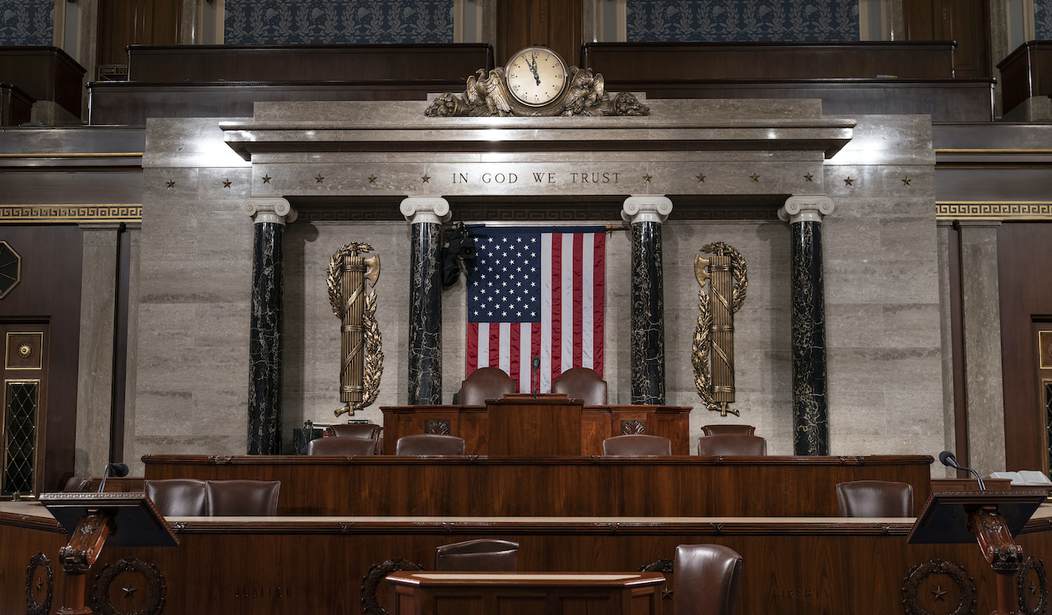
The chamber of the House of Representatives is seen at the Capitol in Washington, Monday, Feb. 3, 2020, as it is prepared for President Donald Trump to give his State of the Union address Tuesday night. (AP Photo/J. Scott Applewhite)
In addition to California’s presidential primary on Super Tuesday, the state held primaries in each of their 54 Congressional districts. J.D. Rucker over at NOQ Reports has identified nine seats, currently held by Democrats, that he believes “are poised to flip from blue to red.” He also believes the single red seat considered to be somewhat vulnerable will stay red. Good news if true. It would certainly go a long way toward restoring a Republican majority in the House.
Rucker writes:
Nine Democratic seats can clearly be flipped and the one Republican seat in jeopardy seems poised to stay red.
Keep two things in mind. First, these aren’t nine seats that are deemed “in play” through some election miracle. These are nine seats currently held by Democrats where Republicans have the upper hand based on analysis of Tuesday’s primary votes. Second—and this is very important to understand—with only one statewide ballot measure, the main draw was the Democratic presidential primary in which Republicans may not vote. That means that even without the draw of a presidential primary choice, nine seats showed Republicans either within striking distance or outright beating Democrats.
The “jungle primary” system for congressional seats means everyone gets the same ballot choices. The top two finishers in the primary will go head-to-head in the general election. Based on these criteria, a shocking number of Democratic seats are now in jeopardy in November.
The San Francisco Chronicle reported on this story as well, although they were slightly less optimistic than Rucker. The Chronicle reported, “Republicans took a strong first step in the primary election toward grabbing back at least some of the seven California congressional districts that Democrats flipped in 2018. With millions of late-arriving mail ballots still uncounted from Tuesday’s election, Republicans have so far combined for a majority of the votes in six of those seven districts. GOP candidates have solid leads in two of them.”
Fred Whitaker, chairman of the Orange County GOP, told The Chronicle, “In Orange County, GOP candidates were winning a majority of the votes in three of the four targeted districts. On Tuesday night, the waters of the blue wave began to recede…and Republicans showed that we will take back Orange County. The pathway to restoring the House of Representatives is through Orange County.”
Rucker goes through each of the districts’ primary results which can be viewed here. I’m including the first one just to show how he arrived at his conclusion. (Rucker posted on Wednesday afternoon, so totals in several districts are incomplete.)
District 7
(98% of precincts reporting)
| CANDIDATE | PERCENT | VOTES |
|---|---|---|
|
Ami Bera (Dem) |
44.5% | 37,120 |
|
Buzz Patterson (GOP) |
38.9% | 32,410 |
|
Jon Ivy (GOP) |
7.8% | 6,488 |
|
Jeff Burdick (Dem) |
6.6% | 5,524 |
|
Chris Richardson (Grn) |
2.3% | 1,892 |
Incumbent Democrat Ami Bera had no trouble beating the other Democrat nor the Green Party candidate, but Republicans Buzz Patterson and Jon Ivy combined to beat him. Though they combine for 46.7% of the vote, the presidential primary boost Bera received did not give him the significant lead he would have hoped for as a Sacramento incumbent.
Patterson, a former carrier of the “nuclear football” for President Clinton, is an outspoken conservative and former Air Force Lt. Colonel. If he can get some wind on his back, he has a strong chance of flipping the seat and beating the incumbent.
Hey Dr. Bera, @RepBera, based on tonight’s results, when would you like to debate the issues? I’m right here.
— Buzz Patterson for Congress (CA-7) (@BuzzPatterson) March 4, 2020
On Election Day 2018, Democrats saw a net gain of 41 seats in the House. The Republicans had held the majority since January 11.
There are 435 voting members plus six non-voting members in the House. A majority requires a minimum of 218 voting members.
Currently, there are 232 Democrats, 197 Republicans, one independent and five vacant seats.
The independent, Justin Amash, was elected as a Republican and became an independent in July 2019. He was the only Republican to call for Trump’s impeachment. He faces serious competition this November and hopefully this seat will flip back into the Republican column.
The Republicans will need a net gain of 21 seats to take back the House. I think it’s doable, especially since Americans have witnessed how the Democrats have abused their majority for the last 14 months. Let’s hope.













Join the conversation as a VIP Member